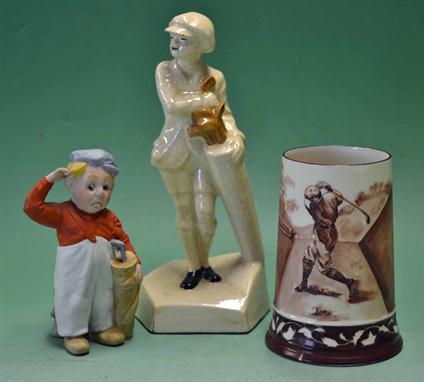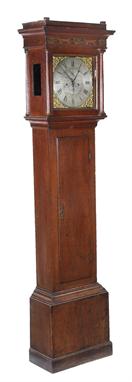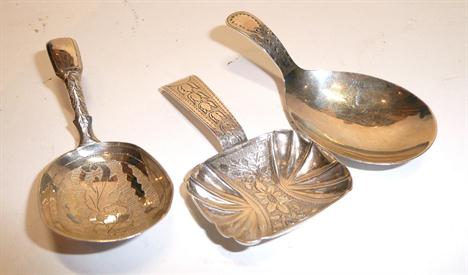We found 81455 price guide item(s) matching your search
There are 81455 lots that match your search criteria. Subscribe now to get instant access to the full price guide service.
Click here to subscribe- List
- Grid
-
81455 item(s)/page
A pair of Edwardian silver candlesticks with reeded columns above circular bases, Birmingham 1905 by Henry Matthews, a William IV silver Fiddle pattern caddy spoon, the rectangular fluted bowl with engraved decoration, Birmingham 1832, a silver mounted photograph frame, Birmingham 1918, a small group of silver cutlery and a christening tankard case (some with faults).
Seve Ballesteros personal Ping "Slazenger" Anser brass putter - stamped Karsten & Co Phoenix Arizona fitted with Avon Track Line grip – the putter was given by Seve Ballesteros to Peter Coleman (Caddy) at The Suntory World Match Play, Wentworth beating Arnold Palmer but after losing to Greg Norman in the Semi Final he decided to retire it and passed onto Peter Coleman – the putter comes with a signed letter from Peter Coleman. Note: Peter Coleman caddie for Ballesteros from 1981- 1983 and then for Bernhard Langer for 22yrs – he also had wins with Westwood, Montgomerie, Norman et al in all 59 tournament wins worldwide
Early Willets Belleek USA golfing ceramic tankard c. 1900 – decorated with a golfing scene in shades of brown and signed by the artist Richardson (long crack from one side to the other plus minor chips along the crack) needs restoring – plus white ceramic Edwardian figure of a Lady golfer (3 cracks to base and heavily crazed) 9.25" h - plus a continental bisque caddy spill vase (G) – 5.5"h (3)
Early Wiltshaw and Robinson Carlton Ware golfing tea caddy c. 1900 - c/w sealed lid fitted with brass locking device – the bowl decorated with red shield, cross golf clubs and balls inscribed "Fore" – the base is printed with makers logo and retailed by Tetley & Son Boar Lane Leeds – overall 5"h x 4" dia (G)
A set of three Dutch silver tea caddies, by Anthony Hoys, Rotterdam 1782, the three rectangular tea caddies with incurved tops with bead borders and finely engraved ribbon and leaf borders, two with pull-off covers and one larger example with hinged cover, all with flower finials, 9cm high, with a filigree caddy spoon, and a pair of bright cut sugar tongs with shell nips, fitted in a velvet lined burr walnut caddy box supported on four unmarked silver claw and ball feet, with silvered handle and escutcheon lock plate, 20cm high to top of handle, approximately 20oz weighable silver including broken parts of the flower finials
A George III oak eight-day longcase clock with unusual chapter ring, Charles and Edward Gillet, Manchester, late 18th century, the four pillar movement with anchor escapement and hour striking on a bell controlled by locking pins fitted to the strike great wheel, the 12 inch square brass dial with subsidiary seconds and calendar dials to the symmetrical scroll engraved centre within applied Roman numeral chapter ring with Arabic five minutes to outer track and unusual half hour markers which comprise of letters to form the name JOSEPH JEPSON the lower edge signed Cha`s & Edw. Gillet, Manchester, the angles with rococo scroll cast spandrels, the case with ogee shaped caddy surmount above cavetto moulded cornice, foliate fretwork frieze and columns flanking the square hood door, the trunk with shaped-top mahogany crossbanded caddy-moulded door flanked by quarter columns to front angles, on raised-panel fronted plinth base with ogee bracket feet, 217cm (85.5ins) high. The partnership between Charles and Edward Gillet is recorded in Baillie, G.H. Watchmakers & Clockmakers of the World as working circa 1790-1800. The name formed from letters positioned as half hour markers is highly unusual and probably spells out the name of the original owner.
An unusual scumbled pine small short duration longcase timepiece with alarm, the dial signed for John May, 18th century, the single-handed movement the with tic-tac escapement and thirteen inch bob pendulum to the three-wheel going train set between narrow frontplate and central movement strip united by two substantial pillars extended at the rear to allow for a further plate to carry the alarm mechanism, with a 7 inch square brass dial with silvered alarm disc and blued steel hand to the matted centre within silvered Roman numeral chapter ring with spear half hour markers and signed John May to lower margin, the angles with applied winged cherub head spandrels, in pine and elm case painted/scumbled to resemble oak with moulded cornice, plain frieze and square glazed door to hood above concave throat moulding and slender caddy-moulded door to trunk, on conforming plinth base with moulded skirt, (with restoration and possible alteration), 193cm (76ins) high. A John May is recorded in Loomes, Brian, Watchmakers & Clockmakers of the World, Volume 2 as working in Bath circa 1740.
A George III oak eight-day longcase clock, George Hewett, Martley, late 18th century, the four pillar rack and bell striking movement with 12 inch square brass dial with subsidiary seconds dial and signed signed George Hewett, Martley to the scroll engraved silvered centre within applied Roman numeral chapter ring with concentric calendar to the inner track and Arabic five minutes, the angles with scroll cast spandrels, in a case with cavetto moulded cornice and three-quarter columns to hood above rectangular caddy moulded door to trunk, on plain plinth base with moulded skirt, 198cm (78ins) high.
An oak eight-day longcase clock, the dial bearing signature for Springer, Stockport, 18th century and later, now with 19th century four pillar rack and bell striking movement fitted to an 11 inch square brass dial with ring turned calendar aperture to the foliate scroll engraved matted centre within applied Roman numeral chapter ring with fleur-de-lys half hour markers and bearing signature Springer, STOCKPORT to lower edge, the angles with female mask and scroll cast spandrels, now in a case with ogee moulded caddy above conforming cornice, blind fret fronted frieze and turned columns flanking dial, the trunk with shaped top door over plain plinth base with moulded skirt incorporating bracket feet, 206cm (81inches) high.
A Victorian carved walnut bracket clock, unsigned, late 19th century, the four pillar twin chain fusee gong striking movement with rise/fall regulation and pendulum holdfast to backplate, the 5 inch wide rectangular silvered Roman numeral dial with fine foliate scroll engraved infill to lower spandrels and around the subsidiary STRIKE/SILENT and SLOW/FAST regulation dials to the extended upper margin, the case with tied swag and acanthus carved decoration to caddy surmount above bevel glazed front door with canted silvered brass fillet insert flanked by fluted canted angles and pierced rectangular frets to sides, on acanthus carved moulded skirt base with squab feet, 35.5cm (14ins) high.
A Victorian rosewood and Tunbridgeware inlaid tea caddy, late 19th century, of rectangular section, the hinged cover with a central panel depicting Eridge Castle, within a band of trailing oak leaves, the waisted body with a band of flowers and foliage to the front, back and sides, the interior with lift out subsidiary caddy with conforming decoration to the hinged cover, beside a circular aperture containing an etched glass bowl, 14cm high, 24.5cm wide
A George III tortoiseshell veneered, ivory strung and silver mounted tea caddy, late 18th century, of rectangular form, the hinged cover with quatreform green stained tortoiseshell panel with mother of pearl inset fleur-de-lys at the points, the silver swing handle and hinges, hallmarked for London 1798, maker`s mark `WS`, with blonde tortoiseshell panels to front, back and sides, the interior with twin subsidiary caddies with hinged covers flanking a star-cut glass bowl, 13.5cm high, 30.5cm wide. Note: There were a number of silversmiths using very similar marks at this period, including smallworkers
A George III burr yew wood sewing box, late 18th century, of rectangular section, the domed and hinged cover with concentric border stringing, a bentwood handle attached at each side, the interior later relined with red felt, 15cm high excluding handle, 23cm wide; and a George III mahogany and marquetry tea caddy, circa 1800, with floral patera inset to the top and a vase motif to the front, 13cm high, 15cm wide
Silver snuff box (Chester 1920), Scottish silver snuff box of circular form by Brook & Son (Edinburgh 1917), Victorian silver vesta case (Birmingham 1897), silver cigarette case by Sampson Mordan (London 1912), silver caddy spoon (Sheffield 1910) and a Victorian white metal / silver plated oval snuff box dated 1899 (6)
A Victorian Silver Caddy Spoon, James Beebe, London 1845, Fiddle pattern with pear shaped bowl engraved with a floral spray, engraved initial M; A George III Silver Shovel Caddy Spoon, Joseph Taylor, Birmingham 1810, of plain form with hollow handle, engraved initial B; Another, Samuel Pemberton, Birmingham 1807, Fiddle pattern; and Another, Lawrence & Co, Birmingham 1816, with hollow handle and allover bright cut decoration (4)
A George III Silver Caddy Spoon, William Eley & William Fearn, London 1815, Old English pattern with scallop shell bowl, engraved initials ES; Another, Josiah Snatt, London 1802, with bright cut engraved handle and scallop shell bowl; and Another, no maker`s mark, London 1788, with bright cut engraved handle and scallop shell bowl (3)
A George III Silver Caddy Spoon, Wardell & Kempson, Birmingham 1814, the rectangular bowl with bright cut engraved floral panel between fluted sides and engraved handle; Another, Joseph Taylor, Birmingham 1817, hollow fiddle pattern with dot-prick engraved decoration; and Another, no maker`s mark, London 1795, with bright cut engraved handle and pear shaped bowl (3)
-
81455 item(s)/page
























































